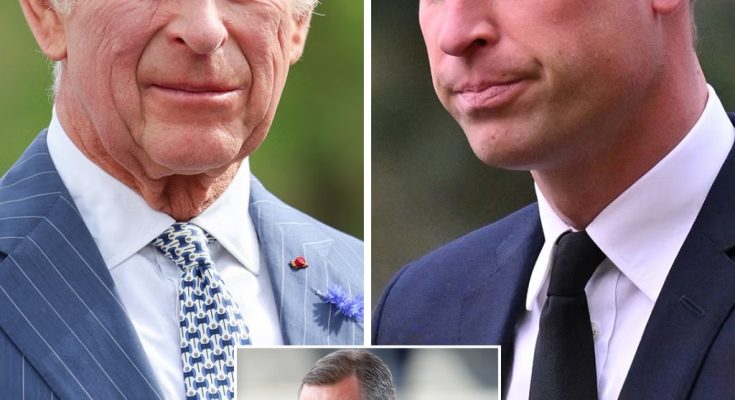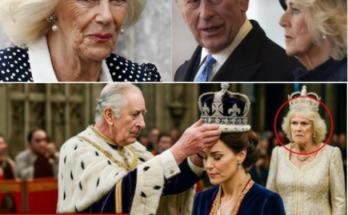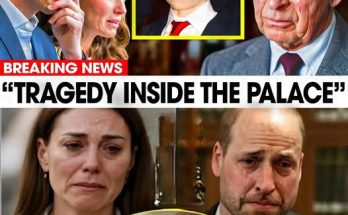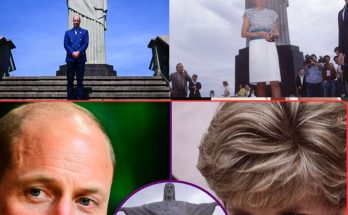The Silent Transition: Inside King Charles’ Secret Test of Power

For months, the British monarchy has stood at the edge of quiet transformation. Behind the walls of Buckingham Palace — where history whispers through marble corridors — a test of loyalty, leadership, and legacy has reportedly been unfolding in silence.
According to a confidential source said to be one of King Charles III’s private secretaries, the monarch’s ongoing battle with an “aggressive cancer” has not only reshaped his personal life but may have become the crucible in which the future of the Crown itself is being forged.
And at the center of that transformation stands one man: Prince William.
A Kingdom Under Watchful Eyes
It began subtly. In early spring, when news first broke that the King was undergoing treatment for a serious form of cancer, palace officials issued calm, measured statements. “The King remains fully engaged in state affairs,” they insisted. “He continues to receive his red boxes daily.”
Yet, those close to the royal household suggest that behind the public serenity, the monarch made a deliberate and deeply personal choice — one that could redefine the monarchy’s transition of power for decades to come.
The private secretary, who spoke to The London Herald on condition of anonymity, described what they called “a carefully designed trial — not of duty, but of destiny.”
“His Majesty saw his illness as a moment of truth,” the aide claimed. “He wanted to see if William was ready — not in ceremony, but in command.”
The Prince at the Helm
For weeks, Prince William reportedly took on a sweeping range of responsibilities usually reserved for the sovereign himself.
From discreetly reviewing state documents and attending confidential briefings with the Prime Minister, to mediating delicate family matters within the Windsor circle, the heir to the throne found himself operating not as a supporting figure, but as the kingdom’s acting conscience.
“William wasn’t given an official title,” said the source. “But make no mistake — he was effectively the decision-maker in every major royal matter during that period. It was a silent handover — a rehearsal for kingship.”
Under his temporary stewardship, the tone of palace operations reportedly shifted. Insiders described a new rhythm — less formal, more pragmatic. Meetings that once took hours were condensed into concise, businesslike sessions. Protocols were respected, but the air grew lighter, as though a new generation’s energy had swept through the gilded halls.
“William’s style is different from his father’s,” said a senior royal correspondent. “Charles is deliberate, contemplative — the gardener-king who cultivates ideas slowly. William, however, moves like a soldier. He assesses, decides, and acts.”
The Hidden Conversations
What makes this transition so fascinating isn’t merely that it happened — but that it was, allegedly, planned.
According to the same aide, King Charles privately told his inner circle months before his diagnosis that he intended to “shape the future rather than wait for it.” When his illness forced him to step back, the opportunity presented itself naturally.
“He viewed his condition as both tragedy and test,” said the aide. “He didn’t want sympathy; he wanted proof that his legacy was in capable hands.”
During the King’s treatment at a private wing of a London hospital, William was said to visit often — not just as a son, but as an apprentice. Between medical briefings, the two men reportedly spent hours discussing the constitutional, moral, and symbolic burdens of the Crown.
It was, in many ways, the conversation of a lifetime — a monarch teaching his successor not by decree, but by experience.
“Charles wasn’t looking for obedience,” the source added. “He wanted judgment — to see how William would lead when no one was watching.”
The Queen’s Quiet Role
Throughout this period, Queen Camilla is said to have played the steady hand — bridging the private fears of the royal family with the public’s yearning for reassurance.
“She became the heart of the operation,” said a palace staffer familiar with internal dynamics. “While William led outwardly, Camilla guarded the King’s spirit and stability. Between them, they built a quiet triangle of trust.”
Her Majesty reportedly encouraged her stepson to take initiative, even when it meant defying old habits. “Camilla has always understood that leadership in the monarchy is about adaptation,” one insider observed. “She saw this moment as a passing of both wisdom and weight.”
A Glimpse of the Future
By late autumn, whispers around Westminster suggested that Prince William had emerged from the experience with a new gravity — his demeanor sharper, his confidence more measured.
He appeared at public events with a restrained authority that observers hadn’t seen before. Gone were the hesitant smiles of a prince waiting in line. In their place stood a man whose time — however unofficially — had begun.
Diplomatic aides noted subtle but unmistakable changes. Correspondence once directed to the King began arriving at Kensington Palace. International envoys requested private audiences with the Prince of Wales, not as courtesy, but consultation.
“Everyone could sense it,” said one senior diplomat. “It wasn’t about replacing the King. It was about preparing the kingdom.”
The Monarch’s Return
In late summer, when King Charles resumed limited duties, insiders described an emotional reunion — not of distance, but of recognition. The test, it seemed, had reached its quiet conclusion.
“William didn’t ask for the role,” the secretary explained. “But he earned something far more valuable than power — he earned his father’s trust.”
The King reportedly told his son, “When the time comes, you’ll already know the way — because you’ve walked it.”
And with that, the monarchy entered a new, unspoken chapter — one defined not by abdication or coronation, but by mentorship. A symbolic passing of the torch, hidden in plain sight.
The Dawn Before the Crown
Now, as the King continues his treatment and the public watches closely for updates on his health, the nation finds itself at an unfamiliar crossroads.
Is this a temporary adjustment, or the first act in a carefully orchestrated succession? No one outside the palace walls can say for sure.
But one thing seems certain: the monarchy, long accused of clinging to the past, is quietly preparing for the future.
The Crown, as ever, endures — not by denying mortality, but by mastering transition.
And in that delicate balance between illness and inheritance, between father and son, a new kind of royalty may be taking shape — one not of ceremony, but of character.



